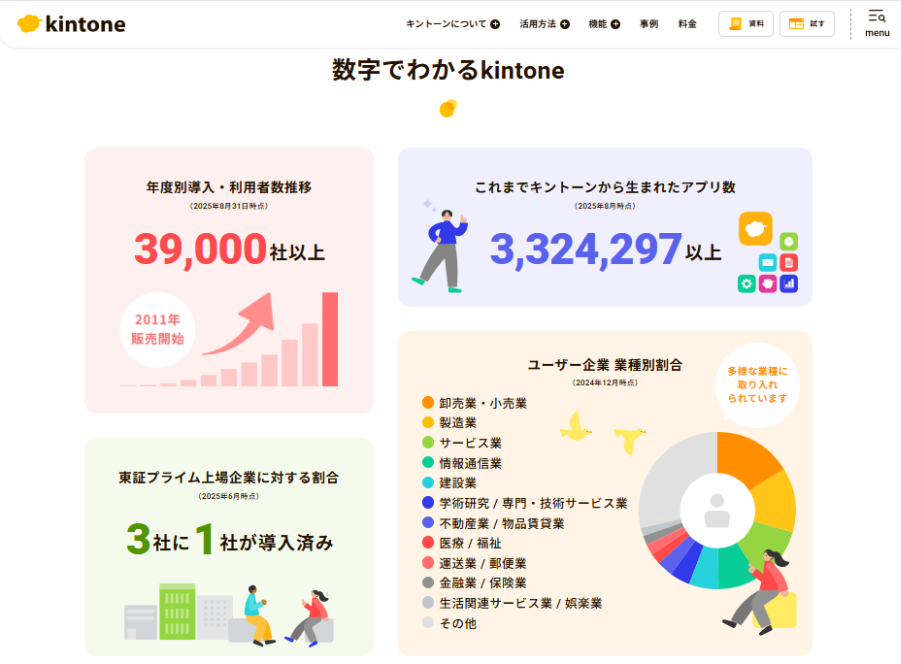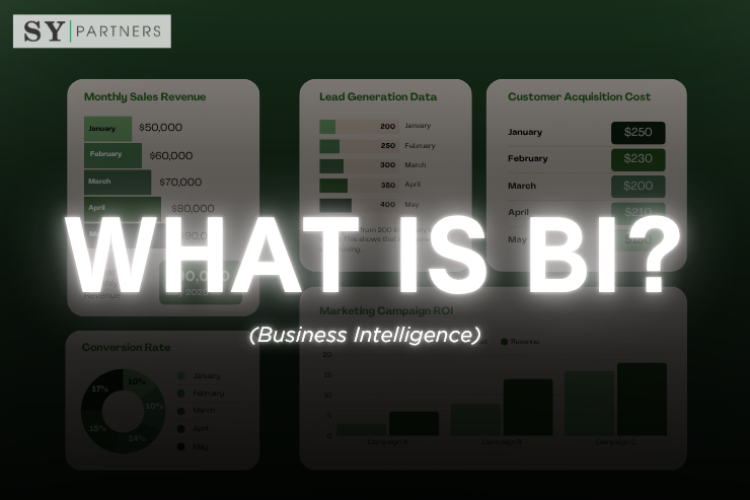What Is kintone? No-Code Mechanics and Real-World Ways to Use It
In today’s rapidly digitalizing business environment, many companies face challenges such as information sharing, operational efficiency, and team collaboration. In particular, the growing complexity of inter-departmental information exchange and project management can cause workflow delays and errors—ultimately hindering corporate growth. Under these circumstances, implementing tools that support efficient operations has become urgent.
As a solution, kintone by Cybozu has drawn increasing attention. kintone is a business-improvement platform that lets you create applications with no-code/low-code, enabling teams to easily build and operate custom apps aligned with actual workflows—even without programming expertise. Thanks to its flexibility and extensibility, adoption has spread widely from SMEs to large enterprises.
This article covers kintone’s fundamentals, explains its key features and pros/cons in detail, and—through real-world case studies—shows which business issues it can resolve and what to watch out for during implementation. Our goal is to provide decision-ready information for organizations evaluating kintone.
1. What is kintone?
1.1 Basic Overview
kintone is a cloud platform for building business apps without programming. Sales management, customer management, inquiry handling, inventory control, and more can be created via intuitive drag-and-drop.
It also includes information-sharing and workflow-automation capabilities—serving as an integrated “database + communication tool.”
1.2 Design Philosophy
kintone breaks away from the traditional notion of “system development = engineering-led,” aiming to let frontline teams build systems themselves as needed. This enables faster improvement cycles and reduces dependency on IT.
1.3 Track Record & Usage
For over a decade, kintone has been used across a wide range of industries. Today, it has been adopted by 39,000+ companies, including one out of every three companies listed on the TSE Prime. This breadth underscores kintone’s flexible applicability regardless of size or sector.
The total number of apps created has exceeded 3,324,000, establishing a strong track record as a tool that supports on-the-ground process improvement and digitalization.

2. How kintone Works
Built around “storing and leveraging information,” kintone lets you easily create apps to manage accumulated data efficiently. Users can either customize from scratch or quickly assemble apps using 100+ ready-made templates.
All data entered into apps is stored on kintone and can be organized and managed by purpose. With well-designed operations, you can enhance traceability, significantly contributing to efficiency and information sharing both inside and outside the organization.
3. Key Features (Summary)
| Feature | Description |
|---|---|
| No-code development | Build apps without programming knowledge |
| Flexible customization | Advanced extensions via plugins/JavaScript |
| Team collaboration | Comments, notifications, and sharing to streamline communication |
| Mobile support | Native mobile apps for on-the-go use |
| API integration | Smooth integration with SaaS and in-house systems |
Crucially, kintone enables immediate reflection of frontline needs in systems—differentiating it from traditional ERP or groupware.
4. What You Can Do with kintone
kintone is more than a system—it’s a multifunctional platform for quickly solving on-site issues and boosting organizational productivity. Beyond day-to-day efficiency, it elevates team collaboration and decision quality.
4.1 Centralize & Share Information
Unify diverse internal data and documents in the cloud. Sales reports, progress tracking, and customer information can be shared in real time across the team. This reduces missed information and duplicate work, enhances transparency, and lowers communication costs.
4.2 Automate Workflows
Automate routine tasks such as approvals, notifications, and task assignment. For example, processing expenses or leave requests in kintone keeps work moving without bottlenecks, reduces manual errors, and frees employees to focus on higher-value tasks.
4.3 Build Original Apps
Without coding, create custom apps tailored to your business—e.g., event management, inventory control, or sales enablement. By turning “on-site wishes” into reality quickly, the speed of improvement rises dramatically.
4.4 Visualize & Analyze Data
Easily convert collected data into graphs and reports. With instant visibility into sales trends or pipeline status, both management and frontline teams make faster decisions. Visual confirmation of numbers and trends enables early problem detection and timely countermeasures.
4.5 Integrate with External Services
Connect with Slack, email, Excel, Google Workspace, and more to work even more efficiently. For instance, updates in kintone can auto-notify Slack, and Excel data can be imported for analysis—reducing tool-switching and double data management while smoothing workflows.
In short, kintone excels as a tool that turns frontline ideas into working systems fast—from small improvements to company-wide transformation, making it a powerful enabler for growth-stage enterprises.
5. What kintone’s Core Features Don’t Cover
While powerful and flexible, kintone’s standard features have limits. Knowing them upfront helps avoid operational issues and extra costs.
5.1 Complex Process Automation
Standard functions handle simple workflows, but complex conditional branching and multi-stage approvals may require JavaScript or external services.
5.2 Advanced Data Aggregation & Analytics
Basic aggregation and charts are supported, but large-scale statistical processing and complex analytics (e.g., BI-grade, multi-sheet cross analysis) require additional tools.
5.3 Design/UI Freedom
While the default UI is simple and easy to use, pursuing a distinctive design or UX exceeds standard capabilities. Plugins or custom code are needed for fine-grained control over layout and presentation.
5.4 Operation Under Heavy Load / Big Data
Optimized for small- to mid-scale datasets, kintone may slow under very large data volumes or high-frequency access. Thoughtful app architecture and integrations are required.
5.5 Specialized Integrations & System-to-System Sync
For specialized needs—e.g., real-time sync with proprietary ERP or custom databases—custom development and API integration are essential. It cannot remain “click-only” in such scenarios.
6. Use Cases
6.1 SMB Process Improvement
SMBs often rely on Excel and paper, leading to delayed sharing and input errors. With kintone, order/inventory become centralized, driving major gains in efficiency and accuracy.
| Area | Challenge | kintone Effect | Example |
|---|---|---|---|
| Order management | Update delays & mis-entries in Excel | Real-time sharing via app | Wholesale: auto-update orders, prevent shipping delays |
| Inventory | Double entry & mismatched counts | Centralized inventory; fewer stockouts/overstock | Retail: auto “stock alerts” for replenishment |
| Customer support | Histories scattered on personal PCs | Shared customer info enables smooth responses | Manufacturing: inquiry histories visible company-wide |
SMBs can achieve “de-Excel / de-paper” operations and maintain high productivity with lean teams.
6.2 Department-Level Use in Large Enterprises
Even with ERP/mission-critical systems, many department-specific routines remain uncovered. kintone serves as a complementary tool.
| Area | Challenge | kintone Effect | Example |
|---|---|---|---|
| Sales | Slow reflection of progress into ERP | Share sales reports instantly | Reps submit via mobile; team-wide progress visibility |
| HR | Training/attendance not integrated | Build HR apps on kintone | Manage training applications & participation |
| Project mgmt. | Cross-department sharing is hard | Centralize tasks in kintone | Manage multi-department projects in one app |
For large enterprises, kintone fills ERP gaps and solves department-specific issues flexibly.
6.3 Public Sector Adoption
Public bodies often process applications/approvals on paper, incurring time and labor costs. kintone delivers efficiency and transparency.
| Area | Challenge | kintone Effect | Example |
|---|---|---|---|
| Application/approval | Paper-based, slow approvals | Digitization enables faster, transparent handling | Municipality: subsidy applications halved processing days |
| Citizen support | Inquiry histories dispersed | Centralized histories enable quick response | Call center: manage citizen inquiries via app |
| Internal ops | General affairs/facility mgmt. person-dependent | App-based ops for efficiency | Schools: online facility reservation management |
In the public sector, kintone drives digitalization and efficiency, improving service quality for citizens.
Conclusion
kintone is an innovative cloud service that enables frontline-led process improvement. It is particularly suitable for organizations that feel the limits of Excel or want on-site teams to improve without relying solely on IT. It is not a full replacement for core systems, so define scope clearly and use it complementarily with ERP/CRM.
By mapping your process scale and target areas, kintone can deliver higher efficiency and stronger cross-team collaboration. Automating applications/reports and real-time sharing of information raises overall organizational productivity.
kintone’s edge is that frontline teams can build and improve apps themselves. While ERP/CRM provide predefined functions/processes, kintone lets you design freely with no-/low-code, systemizing actual workplace workflows. It can serve SFA/CRM use cases, but rather than a single-purpose tool, it’s a general-purpose platform for operating multiple processes across departments/sectors. Hence its growth as an ERP complement, a digitalization enabler for on-site work, and a gap-filler around existing systems.
Success hinges on clear objectives and a solid operating model. Before rollout, specify which processes to improve and who will operate/maintain. kintone’s high flexibility can backfire without design discipline. Define roles for admins, app builders, and users, and start small with 1–2 processes, then expand company-wide after proving value.
Any process involving data organization, sharing, and reporting. Typical areas include sales management, customer response, order/inventory, HR, and project management—where daily records and progress sharing matter. SMBs often replace Excel with kintone; large enterprises use it for on-site tasks and cross-department flows beyond ERP’s coverage. Public/education bodies adopt it to digitize applications/approvals and share inquiry histories, improving transparency and efficiency.
Beyond robust standard features, JavaScript and REST APIs enable advanced operations, such as:
- Custom UI (input-screen design, enhanced charting)
- Real-time integrations (Slack, Google Workspace, Salesforce, etc.)
- Automations with conditional branching and complex workflows
Cybozu’s official kintone plug-ins and partner integrations add advanced capabilities without coding.
Measure reduced development cost and quantifiable efficiency gains. Traditional system builds required significant time and budget for development/maintenance. With kintone, frontline staff create and modify apps themselves, reducing reliance on IT and vendors. You’ll also see immediate impact from shorter processing times, automated reporting, and fewer errors/duplication. Many adopters report payback within a year, with longer-term ROI from higher productivity and faster execution.


 EN
EN JP
JP KR
KR




